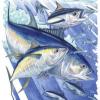Hi Alvia
There is direct relationship of drain weight with processing parameter. This relationship is summarised in the following abstract
Abstract
Mass loss of precooked tuna muscle during retorting and storage in cans impacts cannery yield and throughput. Changes in moisture content and mass of frozen, thawed, precooked tuna muscle chunks, canned in water, were determined after retorting and through five weeks of subsequent storage. Canned tuna pieces were retorted to equivalent lethality (Fo-value of four) for different time and temperature processes. Retorting at a lower temperature, longer time resulted in less mass loss than higher temperature, shorter time processes. Canned storage of up to five weeks had no effect on muscle mass or moisture content.
Effects of retorting and storage on liquid mass transfer in canned skipjack (Katsuwonas pelamis) muscle (PDF Download Available). Available from: https://www.research..._pelamis_muscle
For details please click the link above..
Kind regards
DrHumaid Khan
MD
Halal International Serives
Beverly hills Australia
![]()














